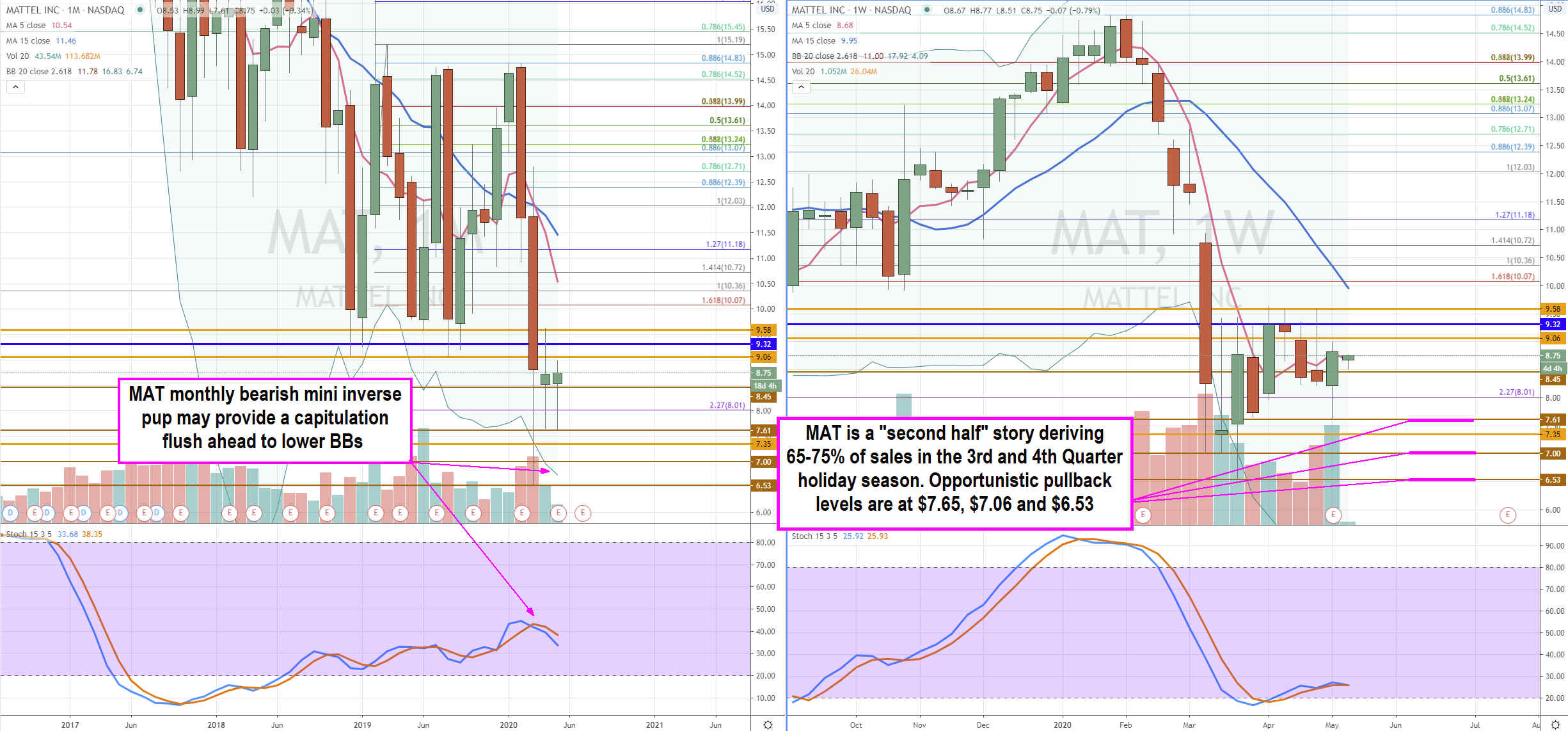
Shares of toy products maker
Mattel, Inc. (NYSE: MAT) were pounded by the COVID-19 panic selling that rocked the markets from on Feb. 19
th through Mar. 23, 2020, as stocks followed the (-35%) plunge in the
S&P 500 (NYSEARCA: SPY). Even as the SPY bounced to recover 62% of its losses, MAT’s bounce got cut short with an awful earnings release. The Q1 2020 earnings release for the quarter ending in March missed estimates by (- $0.20)-per share as revenues came in at $594.1 million missing consensus analyst estimates of $642.4 million, down (-13.8%) year-over-year (YoY). North America sales plummeted (-17%) as the company withdrew FY 2020 guidance. Despite the disastrous results, MAT was able to stage a dead cat bounce off the $7.61 lows. Risk tolerant investors looking for a restart value play should monitor the monthly mini inverse pup for a deeper pullback opportunity
Q1 2020 Earnings Disaster
Mattel had already been implementing a cost-savings initiative that was in place prior to COVID-19. The timely efforts caused one bright spot in the Q2 earnings as gross margins rose to 43% compared to 34.8% and Adjust Gross Margin increase to 43.5% versus 38% YoY. Mattel CEO, Ynon Kreiz, emphasized the company is on the “right path to meet production needs for the second half of the year, leading up to and including the holiday season.” The Company went on to elaborate on the shortfalls due to distribution channels and stores being closed due to COVID-19 throughout the geographical regions. In Latin America, half the retail outlet closures results in a (-14%) decline. The (-17%) decline in North American sales was a result of more than 30% of retail outlets being closed due to isolation mandates to curtail spread of COVID-19. However, gross sales rose 3-5% in January and February heading into March. The Company is seeing improvement in China with the country reopening. Closures resulted in (-7%) point of sale (POS) decline for the month.
Supply Not Demand Disruption
The online retail and e-commerce POS across all regions had very strong growth underscoring strength in the games, construction, arts and crafts and outdoor product. However, the declines in the strongest leadership categories dolls and infant-toddler preschool products suffered the most. Mattel feels this is temporary and expects a return to pre-COVID levels. The Company grew market share in two leader dolls and vehicle categories. April saw supply chain disruptions with temporary closures of certain manufacturing and distribution centers, which still several months away from the beginning of peak production. The issues were supply and distribution rather than demand. This paints a restart and recovery narrative as companies and regions reopen for business. The Company launched “Mattel Playroom”, an online platform and centralized resource for parents to understand the product ecosystem. Liquidity is plentiful with cash on hand and access to $1.6 billion revolver. The goal of transforming Mattel into an IP-driven, high-performing toy company is still on track.
A Second Half Story
Mattel reiterates they are targeting continue improvement in the supply chain and distribution channels are quarantine restrictions are relaxed. The Company is focused on the 2nd half and holiday season as pent up demand should drive growth. Historically, the toy industry has been resilient in economic downturns as parents continue to prioritize spend on their children even during economic contractions. With 65% to 75% of sales coming in the third and fourth quarter, investors should consider the near-term weakness as an opportunity to get a jump on the end of year recovery narrative. Competitor Hasbro (NASDAQ: HAS) shares a similar industry narrative and technical set-up but at a much higher valuation.

Opportunistic Entry Levels
Using the rifle charts on a monthly and weekly time frame provides a broader view of the landscape for MAT stock. The wider monthly trend is bearish with a make or break on the weekly chart. The monthly rifle chart has a bearish stochastic mini inverse pup that remains dormant until the weekly stochastic crosses down. Shares bounced off the $7.61 support level after the Q1 earnings release and coiled back to the weekly 5-period moving average (MA). This weekly make or break will either form a daily mini pup coil back up through the weekly market structure low (MSL)trigger at $9.32 to retest the $10.07 Fibonacci (fib) level with upside to the $11.18 fib before facing the monthly 15-pd MA.
If the weekly stochastic crosses down, then a perfect storm breakdown can trigger to present opportunistic pullback entry levels at the $7.65, $7.00 and $6.53 on the monthly lower Bollinger Band (BBs) overshoot. Traders can use these fib levels to scalp reversions utilizing intraday time frames. Swing traders can scale for overnight to multi-day holds on converging daily/60-minute stochastic. Longer-term investors may consider a pyramid sizing dollar-cost averaging approach with a covered call strategy to buffer downdrafts.
Before you make your next trade, you'll want to hear this.
MarketBeat keeps track of Wall Street's top-rated and best performing research analysts and the stocks they recommend to their clients on a daily basis.
Our team has identified the five stocks that top analysts are quietly whispering to their clients to buy now before the broader market catches on... and none of the big name stocks were on the list.
They believe these five stocks are the five best companies for investors to buy now...
See The Five Stocks Here
Enter your email address and we'll send you MarketBeat's list of seven best retirement stocks and why they should be in your portfolio.
Get This Free Report
Like this article? Share it with a colleague.
Link copied to clipboard.
